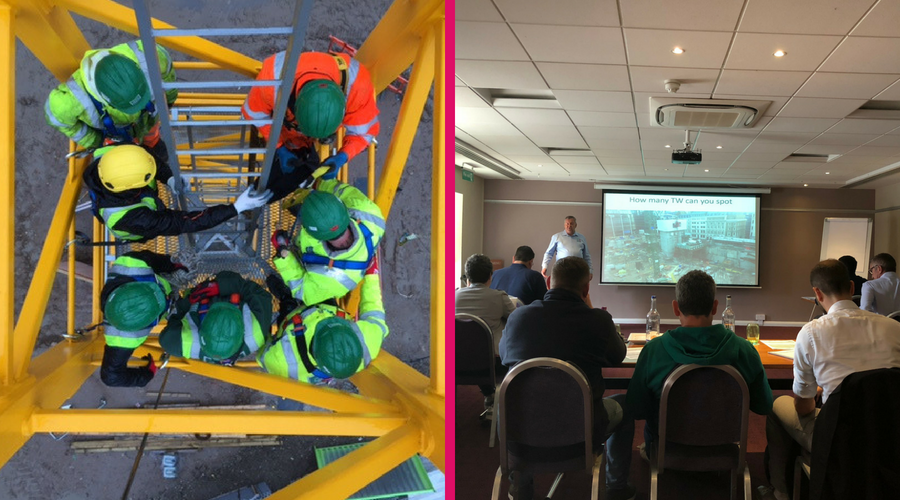Latest News
Is Health and Safety Training a Legal Requirement?
Posted on Friday, 15th March 2019

The Health and Safety at Work etc Act 1974 requires every employer to provide whatever training, equipment, PPE, and information necessary to ensure the safety and health of their staff. This usually includes some form of health and safety training. Here at Essential Site Skills we are a bit obsessed with site safety, and for good reason too. Quality and timely health and safety training for the construction and skilled trades industries can save lives.
Do I Have To Provide Health and Safety Training?
There are many benefits to providing health and safety training.
Firstly, it is your legal duty to protect your staff so far as reasonably practical. The law does not state to what level, but you should provide adequate levels of protection and training for the activities your staff do and the environments in which they work.
For those who work daily on construction sites or carry out high risk activities, you should certainly be providing specialist training and personal protective equipment.
Aside from the legalities, providing health and safety training is good for business.
It demonstrates to your staff that they are valued and cared for. No one wants to go to work and feel unsafe, scared, or undervalued. Those who do feel like that are apt to leave. And a high turnover of staff because your sites are unsafe is not a reputation anyone covets.
What's more, an unsafe working environment can lead to an increase in workplace injuries, meaning staff having time off to recover.
And, of course, along with accidents and injuries at work comes the potential for legal and/civil proceedings, which can ruin businesses and lives.

Who Should Receive Health And Safety Training?
This depends on their role and working environment, but in reality, everyone should receive some form of health and safety training.
However, there should not be a ‘one size fits all’ health and safety training method. For example, a fork lift truck driver will experience different hazards and have a different risk profile to a welder. The receptionist will need different training to the site surveyor. All are exposed to risks in their working day and all should be protected.
There are certain types of employees for whom health and safety is particularly important.
These are new employees, existing employees taking on additional or different duties, and health and safety representatives for your business. Young employees should receive special health and safety training, too, as these people are often more vulnerable to accidents at work. There are specific health and safety considerations for employing young people, details of which can be found here on the HSE website.
How Do I Do Health And Safety Training?
The first step towards health and safety training is completing a risk assessment for each job role to identify the risks associated with them.This, in itself, is a legal requirement for all companies with 5 or more employees.
In the risk assessment, you should identify all the hazards that are present for each location and/or role. From there, a bespoke health and safety training plan can be created. The plan should include how you will test that the training has been effective.
You might want to deliver the training in house. If this is the case, it is important that you can demonstrate the competency of the person delivering the training. Many people choose to use an external provider for specialist training. That way, you know it is done right and your staff are safe.
It is a good idea to make sure accurate training records are kept for each staff member who has received training, That way you can demonstrate it has been done, when it was done, and when it is time for a refresher.
What Should Health and Safety Training Involve?
You should use this opportunity to inform staff of the hazards and risks associated with their role and working environment. They should be fully competent in the measures you have put in place to control the risks. This could include how to use machinery safely, how to fit and adjust PPE and any procedures to follow.
You should also ensure your staff are fully confident in what to do if the worst should happen and they had to follow the emergency procedure.

How Can ESS Help?
Here at Essential Site Skills we are not only experts at delivering high quality health and safety training, but we are also highly skilled and knowledgeable at ensuring work places are safe.
We can come on site and deliver health and safety training on a whole range of courses. Have a look at our course index here to find out more. We can also arrange for one of our highly trained health and safety professionals to come to your site or office and provide health and safety consultancy. This could include policy reviews and creation, auditing, site inspections, risk assessments and even PPE servicing.
Whatever your health and safety needs, and whatever your industry, we can help. Just give us a call on 0115 8970 529, email info@essentialsiteskills.com or fill in our contact form. We will get right back to you.


